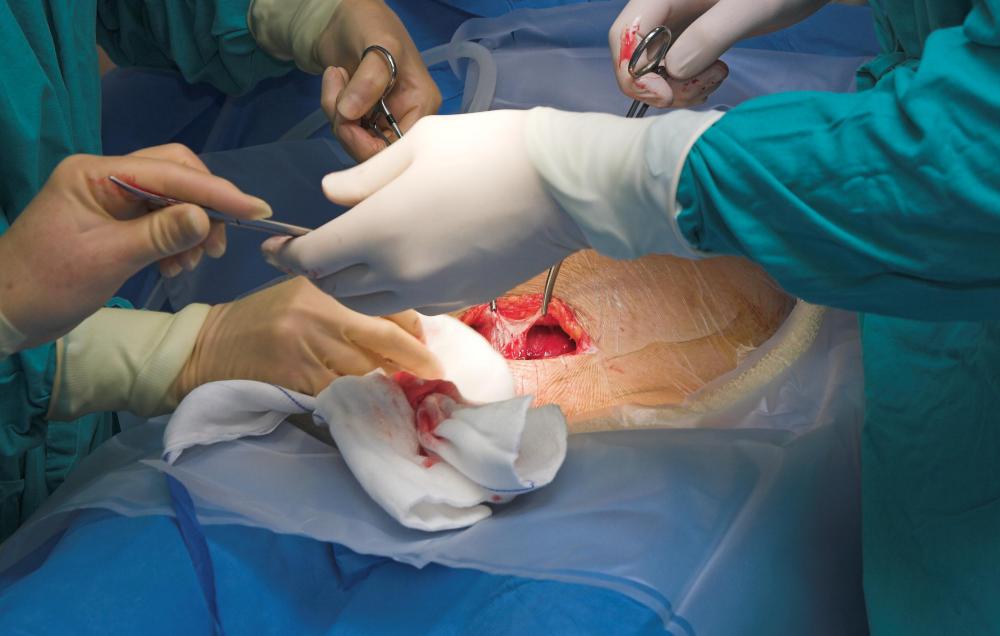At WiseGEEK, we're committed to delivering accurate, trustworthy information. Our expert-authored content is rigorously fact-checked and sourced from credible authorities. Discover how we uphold the highest standards in providing you with reliable knowledge.
What is a Low Lying Placenta?
The placenta is an organ that forms shortly after conception for the purpose of providing necessary nutrients and oxygen to the growing fetus and removing waste products. This organ is very vascular, meaning that it has many blood vessels. Under normal conditions, the placenta positions itself on the upper wall of the mother’s uterus. A low lying placenta refers to a placenta that lies low in the uterus.
Placenta previa refers to a serious condition in which the entire opening of the cervix is blocked by the placenta. The danger of this condition is the risk of excessive bleeding that may occur during or prior to delivery. This condition is also associated with the risk of premature delivery. Placenta previa can be: total, in which the entire cervix is blocked; partial, in which only part of the cervix is covered; or marginal, in which the placenta is close to the cervix but is not actually blocking it. A low lying placenta is another name for marginal placenta previa.

Some women might experience cramping or spotting with a low lying placenta, although most women do not have any symptoms. The condition is first detected by ultrasound during the first 16-20 weeks of pregnancy. This condition occurs in about 5% of pregnancies, but the majority of these cases will resolve as the pregnancy progresses. This is due to the fact that as the baby gets bigger, the placenta often moves from the cervix.

In the cases of low lying placenta that do not resolve naturally, certain precautions will usually be taken as the pregnancy progresses. The mother will most likely be told to avoid most activities, and may even be ordered to bed rest for the remainder of the pregnancy. A cesarean section will almost always be performed. This procedure is necessary to prevent potentially heavy bleeding during delivery that would pose danger to the mother and the baby.

Although there is no single known cause of low lying placenta, several factors are associated with developing this condition. A previous cesarean section or other uterine surgeries, such as the removal of endometrial polyps via a dilation and curettage (D and C), appear to put women at a higher risk. Women who have had a low lying placenta in previous pregnancies are also at a higher risk. Other risk factors include having a larger placenta, such as in the case of being pregnant with twins or triplets, being over 35, being a smoker, or having an abnormally shaped uterus.
AS FEATURED ON:
AS FEATURED ON:















Discussion Comments
@babylove - My eighteen week ultrasound showed low lying placenta too during my third pregnancy and I ended up having a normal delivery with a healthy baby.
I was scared too at first, but the way the nurse explained it to me is that normally the placenta will develop at the top of the uterus but it can sometimes develop at the bottom.
In most cases when this happens, the placenta moves to the top as the uterus grows. Your doctor will probably order another ultrasound around your thirty-second week just to see how things are developing.
As mentioned in the previous post, it is important to get the rest your doctor has requested and let them know if you experience any cramping or spotting.
@babylove - The most important thing you should do is to try and stay calm. You don't want to put any additional stress on your baby. The second thing you should do, is listen to your doctor and do as he/she says.
You probably don't have any of the usual low lying placenta symptoms, like bleeding, spotting or cramping because you're still in the very early stages of your pregnancy. I'm sure that's why it's such a shock to you.
Your doctor may never know what actually caused it, but they obviously know that jogging and strenuous exercise could make it worse, along with heavy lifting and intercourse.
I'm sure it's too early to tell if you'll have to have a C-Section. But one thing to keep in mind is that the placenta can move as the baby grows, so there's a very good chance that everything will straighten itself out long before your delivery date.
Hi, I'm in the nineteenth week of my second pregnancy and my OBGYN just informed me after my last sonogram that I have low lying placenta previa.
I was shocked! I've always considered myself to be a very healthy person. I exercise daily, I job three times a week, I eat a well balanced diet and I didn't have any problems during my first pregnancy.
I've been ordered to stop exercising and no more jogging until after my baby's born. I'm totally devastated by this. What could have caused it? Do you think I'll have to have a C-Section?
Post your comments